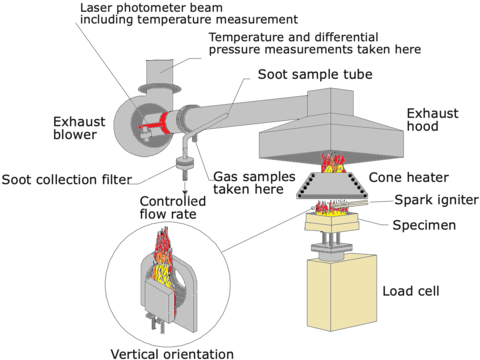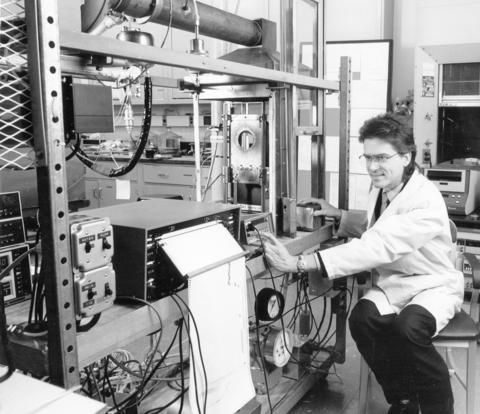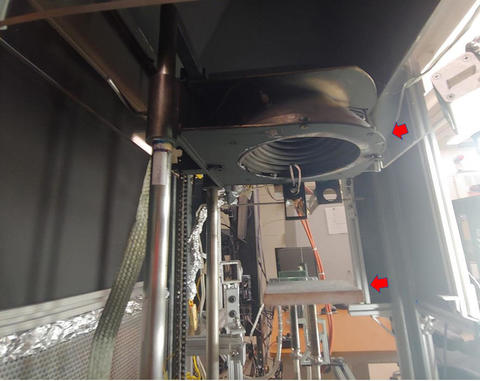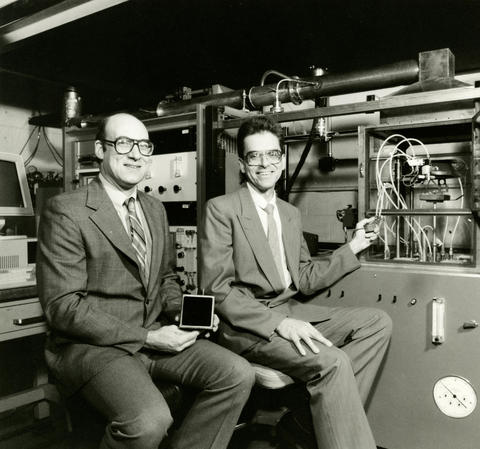
After 40 years in service as a groundbreaking NIST-invented device for measuring the flammability of materials at the lab bench scale, the NIST cone calorimeter is being retired and will be replaced with a commercially produced system modeled on its design. The transition is tentatively scheduled to be completed by the end of the summer of 2022. Flammability Reduction Group Leader Rick Davis and supervisory librarian Keith Martin are working to see what parts of the original “mother” cone calorimeter could be put on display in the NIST Museum to commemorate the device’s role in advancing the science of fire safety testing.
“The cone calorimeter is the standard test method that the world’s fire safety research community uses to confidently select and develop materials to meet regulations, standards and codes for the fire performance of products used in a large variety of different applications. It has helped save lives,” Davis says.
“We’re replacing the NIST ‘mother’ cone calorimeter with a modern commercial cone calorimeter because the start-up, operation, analysis and maintenance of the newer system is more streamlined and its design mitigates the need for some of the safety controls we have had to put in place for the original,” Davis explains. “Because the commercial cone calorimeter is easier for people to learn how to operate, we can have more people trained and using it. This will increase our research productivity without sacrificing our research quality.”
The NIST cone calorimeter was invented by former NIST researcher Vytenis Babrauskas, with the help of NIST technician Dave Swanson who prepared shop drawings for the device and machined its parts. The cone calorimeter was first described in November 1982. It measures a material’s flammability using the technique of oxygen consumption calorimetry (OCC), which determines the heat release rate of a fire by measuring the amount of oxygen the fire consumes. In the late 1970s and early 1980s, NIST researchers William Parker and Clayton Huggett provided the scientific foundations necessary for OCC to be implemented for fire safety research, a feat for which Parker received the 2016 DiNenno Prize, which is given by the National Fire Protection Association to recognize innovations that have significantly enhanced public safety. (Huggett’s efforts were recognized, but he died in 1998 and thus was ineligible to receive the award since it is never bestowed posthumously.)

The cone calorimeter enables researchers to accurately and inexpensively test the flammability of small samples of materials, typically a square around 100 x 100 millimeters (3.94 x 3.94 inches). OCC can also be employed at larger scales ranging from the burning of a single piece of furniture to an entire furnished room.
Heat release rate is the most important thing to know about a fire, as it determines the size of the fire, how quickly the fire will spread, and how quickly the fire will produce dangerous gases. The relationship between oxygen consumption and heat release rate was first recognized by William Thornton of Armstrong College in England (now Newcastle University) in 1917. The need for an accurate means to measure heat release rate for fire safety research was first discussed by Harvard University’s Howard Emmons in 1959, but the early methods devised to measure it using only temperature and gas flow rate were of low accuracy, prone to error and difficult to perform.
Testing flammability using OCC, by contrast, is easier to perform and gives more accurate and consistent results.
The NIST cone calorimeter was named for one of its components: the open-ended cone-shaped electric heater that lets researchers precisely control the heat to which the sample is exposed, simulating heat sources (such as a burning wall) that one might find in a room fire scenario. Researchers can ignite the sample using the heat from that heater or an electric spark ignitor like that found on a modern gas stove. The test sample rests upon a sensitive scale to measure the sample’s loss of mass during combustion. The products of the fire flow up into an exhaust system where instruments measure the oxygen consumption, and thus the heat release rate, as well as a host of different properties, such as smoke and toxic gas production.

NIST’s “mother” cone has undergone constant improvement during its tenure and owes a great deal of its capabilities to the work of not only professional NIST scientists and engineers, but also technicians such as Dave Swanson, Randy Shields and Bill Twilley. Twilley, a master electrician with engineering training who intimately understood the science of OCC and the workings of the cone calorimeter, helped industry partners develop it as a commercial product, trained NIST fire researchers on the instrument’s function, calibration and operation, and provided support to other federal government agencies seeking to build their own cone calorimeter. He was the lead author of the 128-page User’s Guide for the Cone Calorimeter, published in 1988, and co-authored other publications about the cone calorimeter, including one introducing a means of using it to study fire in oxygen-depleted environments.
The cone also earned Babrauskas and Twilley an R&D 100 Award in 1988. It was the first fire test method ever to be recognized with one of these awards, which are widely recognized as the "Oscars of invention."

In evidence of the instrument’s effectiveness, there are now more than 300 cone calorimeters in use around the world, all based on the original NIST design. The cone is used in several fire safety testing standards, including ASTM E1354-17, ASTM D5485-21, ASTM D5485-99, ISO 5660-1:2015, and ULC-S135.
“The cone calorimeter is most definitely the most important tool ever to be created in the field of fire safety science and flame-retardant research,” says former NIST National Research Council postdoc and present University of Dayton fire researcher Alex Morgan. “Its ability to quantify material flammability as a function of fire threat, and to simultaneously measure mass loss, gas production rates, combustion efficiency, and smoke release in a well-ventilated fire threat scenario is unique. It has greatly advanced fire safety by quantifying fire threats for a wide range of materials, from solid plastics to wire and cable materials, to aerospace composites, to carpeting, fabrics, furniture sub-assemblies and just about any modern material used today. You can certainly use other fire test methods, but the cone calorimeter is the preferred instrument for publications and scientific discussion, and I would argue is the first instrument you reach for when developing new fire-safe materials.”
Although the “mother” cone will soon be replaced, that won’t stop NIST researchers from adding new capabilities to its replacement device and seeking to guide the development of the tool for the fire safety research community. According to NIST materials science engineer Mauro Zammarano of the Flammability Reduction Group, the original NIST cone calorimeter was recently outfitted with three synchronized air-cooled cameras that can record video of a test sample fire at 30 frames per second at a high-definition resolution of 1080p. That camera system will be added to the new cone calorimeter once it’s in place.
“This camera system is a unique feature of the NIST cone calorimeter that is now under development in commercial cone calorimeters, and I believe will eventually be implemented in all cone calorimeters,” says Zammarano, who designed the camera system with NIST researchers Matt Bundy, Artur Chernovsky and Randy Shields. “The ability to document a fire test from three different viewpoints accompanied by real-time data on the heat release rate is extremely valuable for testing, reporting and understanding a material’s fire behavior.”
Deaths due to fire in homes have been reduced in the past 40 years, thanks in some part to new fire-resistant materials and safety standards that were developed using the cone calorimeter. NIST researchers are using the device now to evaluate the performance of fire-barrier fabrics in multilayered products (e.g., upholstered furniture), which may serve as an alternative to potentially toxic chemical fire retardants.
The NIST mother cone calorimeter and its spawn of daughters have helped save lives, and while the mother cone is being laid to rest, it’s legacy will live on. NIST researchers are building upon that legacy and will use the successor device to create new and more rigorous tests, leading to a more fire-safe environment for us all. Happy retirement, cone calorimeter!

